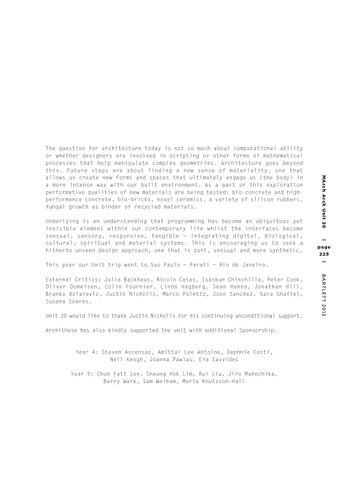Underlying is an understanding that programming has become an ubiquitous yet invisible element within our contemporary life whilst the interfaces become sensual, sensory, responsive, tangible — integrating digital, biological, cultural, spiritual and material systems. This is encouraging us to seek a hitherto unseen design approach, one that is soft, sensual and more synthetic. This year our Unit trip went to Sao Paulo — Parati — Rio de Janeiro.
Unit 20 would like to thank Justin Nicholls for his continuing unconditional support. Archithese has also kindly supported the unit with additional Sponsorship.
Year 4: Steven Ascensao, Amittai Lee Antoine, Daphnie Costi, Neil Keogh, Joanna Pawlas, Era Savvides Year 5: Chun Fatt Lee, Sheung Hok Lim, Rui Liu, Jiro Munechika, Barry Wark, Sam Welham, Maria Knutsson-Hall
— page 225 — B A RT LET T 2012
External Critics: Julia Backhaus, Nicolo Casas, Isaskun Chinchilla, Peter Cook, Oliver Domeisen, Colin Fournier, Linda Hagberg, Sean Hanna, Jonathan Hill, Branko Kolarevic, Justin Nicholls, Marco Poletto, Jose Sanchez, Sara Shafiei, Susana Soares.
MArch Arch Un i t 2 0
The question for architecture today is not so much about computational ability or whether designers are involved in scripting or other forms of mathematical processes that help manipulate complex geometries. Architecture goes beyond this. Future steps are about finding a new sense of materiality, one that allows us create new forms and spaces that ultimately engage us (the body) in a more intense way with our built environment. As a part of this exploration performative qualities of new materials are being tested: bio-concrete and highperformance concrete, bio-bricks, novel ceramics, a variety of silicon rubbers, fungal growth as binder of recycled materials.
